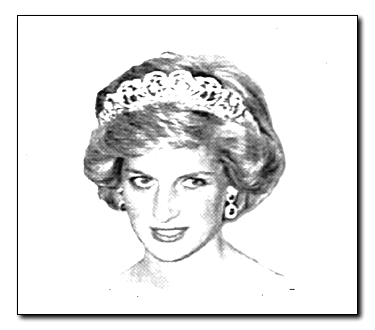![]()
![[ OPINIONS ]](/images/fall97/opinionsf97.gif)
![]()
By Brad Senning
Arizona Daily Wildcat September 16, 1997
One last stab at Diana's death
![[Image is Loading. No, Really, it is.]](05_1_i.gif)
Brad Senning |
Something happened on that bitter Paris morning when a speeding Mercedes
became a royal death container. Something dramatic and alarming and good
grew from those dead bodies bleeding in the flash of greedy cameras. Something
developed in our ability to see the blue-blooded wreckage live via satellite
or peel open a tabloid spread where the freshness of the accident is evident
in the time-lapse dilation of pooling blood in photographic stills. As if
looking in a mirror and seeing ourselves doubled, we were forced into a
focus of apperception.
Princess Diana was a figure of world renown, dubbed a "princess of the people" by the people. She was as much a part of world diplomacy as pop culture, embraced by distant countries and all ages. If she was ambitiously pursued by the press and by the people, it's because she was too perfect, too well-liked, an image almost begging to be slimed.
Her service was attended by a motley collection of individuals, all in accordance with the fairy-tale landscape of the princess's life. Among friends and family were aging musicians Elton John and Sting, "Far and Away" stars Nicole Kidman and Tom Cruise, rubber-gloved diplomats Henry Kissinger and Hillary Clinton, and enough "royals" to choke an ambitious dragon. Those not in attendance: the paparazzi (doesn't this name suggest a sense of fatherly chic combined with a twirl of pasta?). Much like the Ancient Mariner of Coleridge, these paparazzi wear the albatross for Diana's death.
It's compulsory in this world of push-button ease to quickly assign the blame to the nearest at hand. The paparazzi were engaged in a high-speed chase with Diana's car, thereby causing a reckless situation. Then we discovered the driver of Diana's car was quite intoxicated. Tabloid employees were reported to breath, "Thank God for that drunk Frenchman." - anything to ease the burden her death might have weighed on their bottom line or on their freedom to pursue royalty.
The tabloids wouldn't be covering royalty if there weren't any consumer demand. In September 1980, an English tabloid, the Sun, changed the way media covered so-called "royals" by scooping the story of Prince Charles and a 19-year-old woman named Diana Spencer. Tabloid editors quickly dispatched more royal reporters when a trend was noticed: Diana's picture on the front page equaled more sales. (That famous line from All the President's Men, "follow the money," remarkably embodies the motivational soul of post-Watergate media.) In 17 years' time, nothing had changed. People wanted to see something remarkable about Diana every week, if possible, so more reporters were hired to follow her.
But don't let mainstream publications convince you it's just the tabloids feeding on her celebrity. In fact, tabloids are often only breaking the news; then publications such as Newsweek glom on, not only retelling the story, but buying the photographs. As lice travels from dog to dog, so does bad press from publication to publication.
Why not? Readers worldwide had a penchant for England's royalty. Why not kowtow to demand like most industries do?
A Kuwait businessman is publicizing his offer of $1 million for the totaled Mercedes. Philatelists in Hong Kong are paying up to $950 on commemorative postage stamps. Americans are spending $1,000 a pair for earrings made of beads from one of the princess's auctioned dresses. If the common man had been let in the funeral service he might have stolen rose petals from young Prince Harry's floral arrangement (the darling centerpiece of any periodical's "funeral edition" - the one which innocently read "Mummy" on a standing white card).
There are a lot of demented demands out there, but, fortunately, we've passed laws against selling child pornography or owning lampshades made of human skin. While people are berating the paparazzi, crying that they've gone too far, you can also hear them whispering from dark corners in their unconscious mind, "So when do we get to see the accident photos?"
We all need to see the ugly side of ourselves. That's the position Diana's death has forced us into. It isn't the mongrel paparazzi who deserves the blame; it isn't the avaricious world consumer; and the drunk Frenchman who drove the car was certainly pursued by something darker and more malicious than he could soberly evade. The answer, cliché in its scope, is that we are all blameworthy. We need to look within ourselves and find the mindfulness which questions what we consume and who it's effecting. We need to look into the dislocated pictures of Diana - not at them, but into them - and find her anxiety, and stand away because she doesn't want the photographer there or us there or our dollars contributing to the emergence of more candid pictures.
We will forget. The modern memory lasts as long as "Seinfeld" and is getting just as dull. Meanwhile, Diana memento mori clog the marketplace and the Diana "Commemorative Issue" put out by Newsweek is only $4.95. (When will we get to see those accident photos?)
Brad Senning is a senior majoring in American literature and creative writing.




